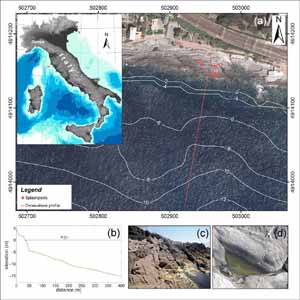Sea-level change and the supralittoral environment: Potential impact on a splashpool habitat on the Ligurian coast (NW Mediterranean)

Accepted: July 2, 2022
All claims expressed in this article are solely those of the authors and do not necessarily represent those of their affiliated organizations, or those of the publisher, the editors and the reviewers. Any product that may be evaluated in this article or claim that may be made by its manufacturer is not guaranteed or endorsed by the publisher.
Authors
Climate change represents one of the major drivers of habitat modification that is affecting a wide variety of environments. In coastal environments, great effort is being put in trying to understand and forecast the possible effects of such processes, and the Sea-Level Rise (SLR) is one of the most investigated phenomena. This paper describes the possible effects of different 2100 sea-level scenarios related to greenhouse gas mitigation policies (Representative Concentration Pathways - RCPs). This work was conducted on a supralittoral habitat situated in Genova (Ligurian Sea), and has covered an eventual change of environmental conditions driven by SLR, which might impact the Culicid Acartomyiamariae, a resident species. The wave run-up stemming from the different RCPs was simulated using the XBeach model, and to infer SLR effects on A. mariae life cycle; the results were coupled with data obtained from field surveys. The model outputs highlighted a variation in the wave run-up oscillations under common wave conditions, which might affect the supralittoral area in terms of water input and hydric balance, and the A. mariae life cycle, which is highly dependent on temperature and salinity.
How to Cite

This work is licensed under a Creative Commons Attribution-NonCommercial 4.0 International License.
PAGEPress has chosen to apply the Creative Commons Attribution NonCommercial 4.0 International License (CC BY-NC 4.0) to all manuscripts to be published.

 https://doi.org/10.4081/jbr.2022.10485
https://doi.org/10.4081/jbr.2022.10485



